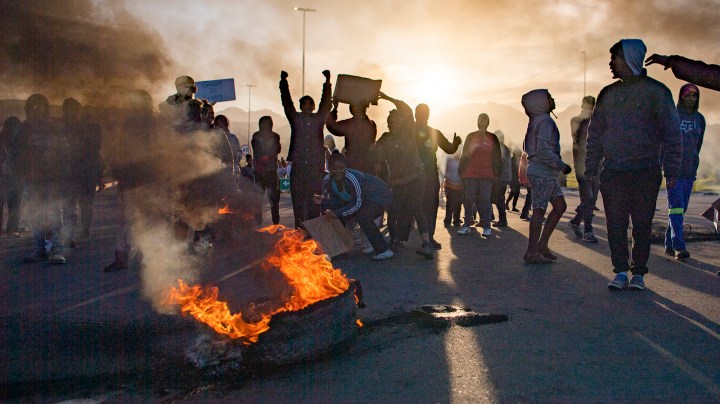CIVIL UNREST
Service delivery protests surged in January as power cuts ramped up, research company finds

The main trigger for January’s unusually high levels of service delivery protests in South Africa was the increased intensity of Eskom’s rolling power cuts, says research company Municipal IQ.
The scale of rolling blackouts to prevent a grid collapse in mid-summer has raised alarms that the winter of 2023 will be one of darkness. And if that’s the case, it looks like it will also be a winter of turbulent social discontent.
“Protests spiked to a seldom-seen high, very uncharacteristic for January after a six-month drop-off in protest action last year. There is no doubt that the spike in protests was caused by load shedding. This represents a clear risk to social stability in municipalities and government needs to act,” Municipal IQ, a research company that monitors service delivery protests said in its analysis of the January data, which it shared with Business Maverick.
“There were 32 major service delivery protests recorded in January 2023. It’s clear from Municipal IQ data that protests spiked to a high level in January after a six-month decline in protests from the previous mid-year high of 31 in June last year. This is worrying and does not bode well for the year,” the analysis said.
January 2023 was not the worst month, according to Municipal IQ’s database, which goes back to 2004. But the company’s managing director Kevin Allan told Business Maverick that it was the worst January – by a long shot – for such protest activity over the past 19 years.
“More than 30 protests a month are quite rare and may well signify the beginning of a high protest season in 2023. In 2018 and 2019, years which saw the highest protest numbers since protests started in 2004, we saw only three months where protests spiked to more than 30 protests a month (May 2018, June 2018, and April 2019),” the analysis said.
“Another ominous sign is that it is very rare to see protests at such a high level in January where typically protests start off at quite a low rate at the beginning of the year after the lows of December and build up to a peak in the winter months. This may well also point to a protest-stricken year this year.”
Ominous indeed, given that the root cause — the growing number of power cuts — is not going to improve any time soon.
“Municipal IQ has done an analysis of protest cause over the last three months broken down by subcategory — electricity, sanitation, water, refuse removal, housing, service delivery, and other. The spike in protests across the board is clear, but it’s also clear that the high number of total protests is driven by high numbers of electricity and water protests. Electricity and to a great extent water issues dominated protest activity again last month,” the analysis said.
“It should also be noted that in about half of all water protests, communities’ complaints are directly related to water outages caused by load shedding, and in the remainder, although unclear (because it is often unstated), there is a strong possibility that many of these protests are also in some way related to or exacerbated by load shedding.”
Visit Daily Maverick’s home page for more news, analysis and investigations
In short, the power crisis is triggering social unrest on a range of fronts, and things look set to get worse.
This disturbing trend highlights how the power shortages, and state failure more generally at the hands of the ANC, are undermining South Africa’s social fabric and economy.
There will be almost no — if any — economic growth this year because of Eskom’s inability to keep the lights on. The central bank’s estimate of the impact of the power cuts on economic growth is as much as two percentage points, while accounting firm PwC has pegged it as high as five percentage points.
This in turn will add fuel to the protest fire, as badly needed jobs will not be created, leaving millions mired in poverty in small towns and informal settlements and rural areas where the state barely functions. And all of this is happening against the backdrop of stagnant and declining wages for the employed and high inflation, notably for food.
The US embassy issued a Level 2 travel advisory on 15 February to its citizens travelling and living in South Africa after the energy State of Disaster was declared.
“The U.S. Embassy would like to take this opportunity to remind U.S. citizens traveling to or living in South Africa that South Africa has a Travel Advisory Level 2: Exercise Increased Caution due to Crime and Civil Unrest,” it said (italics added).
“Prepare in advance for power outages, including contingencies for communication and water. Maintain 72-hours’ worth of supplies at home by stockpiling non-perishable food, 3 liters of drinking water per person per day, and medicines and first aid supplies.”
The US State Department does err on the side of caution and will have many citizen alerts active at any time. Still, it’s hardly a great signal for foreign investors and tourists — bring your own water and flashlights.
And civil or social unrest is indeed on the rise in the world’s most unequal society, and this is largely a consequence of the extent of power outages. Among other things, this is surely a bad political scenario for the ANC. Which of course explains why it is so desperate to fix the mess it made before next year’s elections. DM/BM

















 Become an Insider
Become an Insider
Comments - Please login in order to comment.